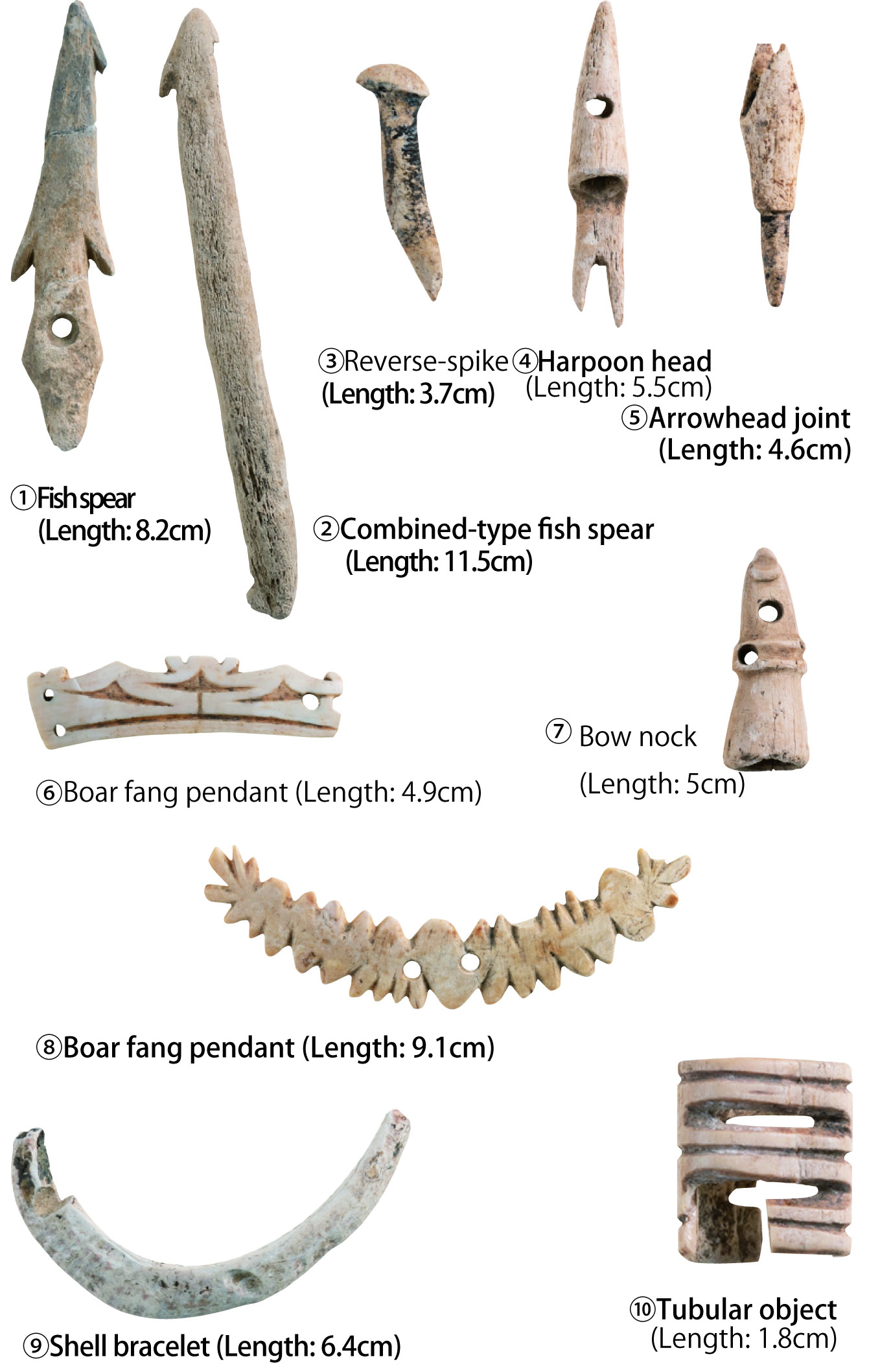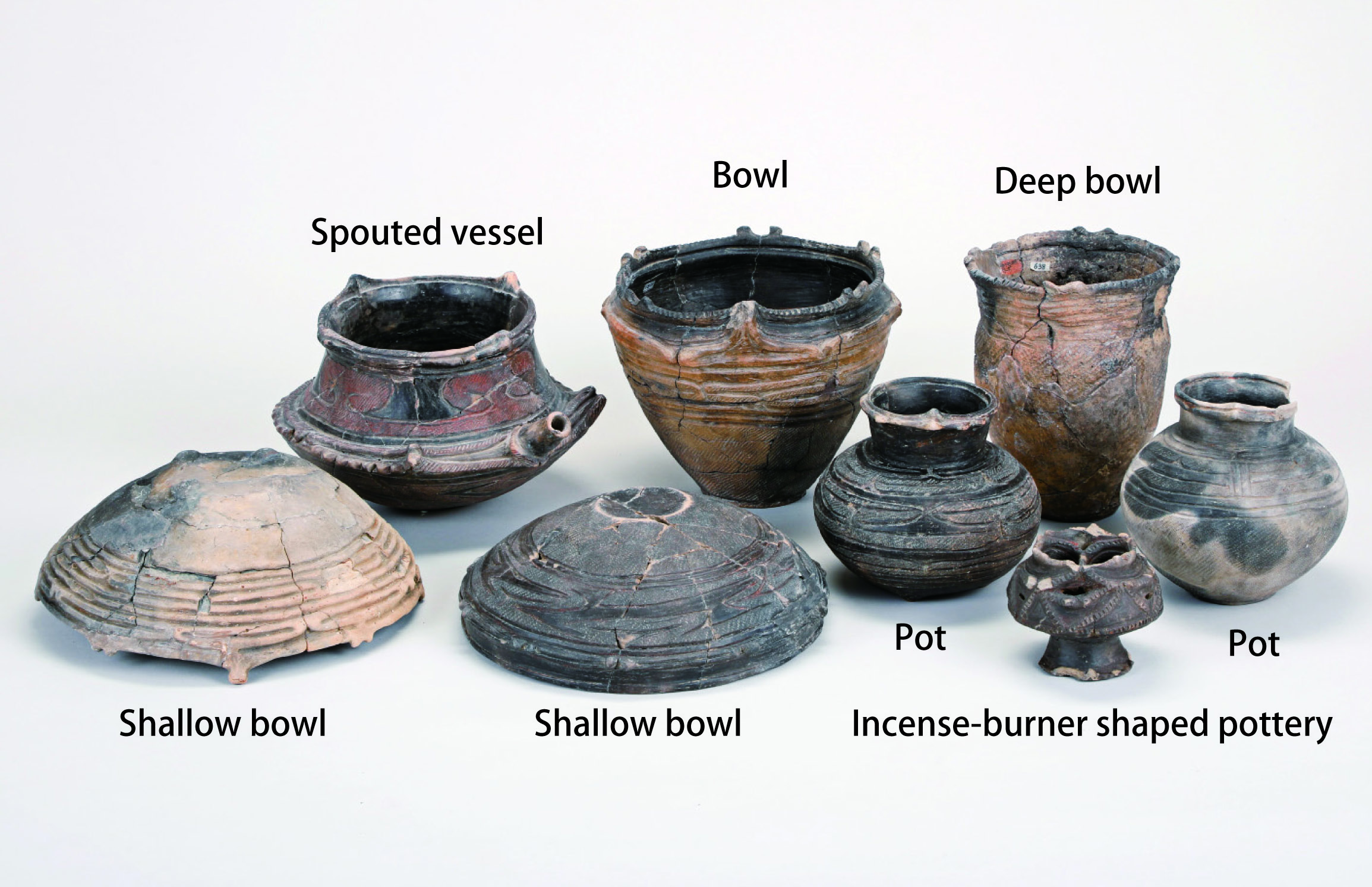Minamisanriku, Miyagi Prefecture
Middle Late to Final Stage Jōmon Period (ca. 3500-2600 years ago)

North-south section of the shell strata (facing westward)
The maximum thickness of the upper shell stratum is about 75 cm. At some points, the upper shell stratum was divided into more than 300 fine strata due to differences in the composition of the shells and soil. The maximum thickness of the lower shell stratum was approximately 10 cm.


A distant view of the site
The site is located on the northern slope of the eastern edge of the hill extending from the west. The Mizushiri River, which flows immediately to the north, passes under National Route 45 seen in the foreground and immediately empties into Shizugawa Bay.

Tuna (left) and deer (right) vertebrae with an embedded stone arrowhead
Based on the angle of the arrowhead, it appears that the arrow or harpoon head was shot diagonally above the tuna’s head. The arrowhead left in the deer’s vertebrae penetrated deeply, allowing it to remain embedded in the bone. Both excavated from the upper shell stratum. The length of the arrowhead embedded in the tuna vertebrae is 2.8 cm, with the the diameter of the tuna vertebrae itself being 3.9 cm; the diameter of the deer vertebrae is 2.9 cm.

Land mammals found in the upper shell stratum
Wild boar, Japanese deer, wolf, dog, fox, raccoon dog, otter, marten, weasel, hare, flying squirrel. More than 20,000 animal bones were excavated from the upper shell stratum. Seventy percent of the bones were of wild boar and Japanese deer, with many of the wild boars being younger than one year old.

Bone, horn, tusk, and shell implements excavated from the upper shell stratum
⓵ through ⑤ are hunting and fishing tools made of deer antler. The combined-type fish spear ② is attached to the handle in pairs, and a reverse spike (③ is attached to the end to keep fish from escaping when caught between them. ⑥ through ⑩ are ornaments. The shell bracelet is made from patellogastropoda shell, found in the Izu Islands, as well as south of Yakushima Island.

Stone tools and implements excavated from the upper shell stratum
Stone arrowheads, stone drills, and spoon-shaped stone knives are made of siliceous shale, which are not found in the vicinity of the site. On the other hand, other tools are made of stone varieties that can be found in the surrounding area, showing that different stone was used for different tools. Stone swords with trapezoidal heads are similar to those found in the middle reaches of the Kitakami River in Iwate Prefecture. The length of the preserved section of the phallic stone rod is 23.9 cm.

Pottery excavated from the upper shell stratum
Several parallel lines are painted on the long rim of a deep bowl – most commonly found at sites in the middle basin of the Kitakami River in Iwate Prefecture and are rarely excavated in Miyagi Prefecture. The spouted vessel, shallow bowl on the right, and pot on the right have a cloud-shaped design (see fig. 1), characteristic of the Middle Late Period. The shallow bowl on the left and the pot on the left have a kouji pattern, which is characteristic of the Late Late Period. The bowl, the shallow bowl on the left, and the pot on the left have “kouji-mon” patterns characteristic of the late stage of the late Jōmon Period. The shallow bowl on the left has a rim of 20.5 cm.

Clay implements excavated from the upper shell stratum
The clay mask is decorated with a pattern called “paiji-mon” (pi-symbol pattern) which is characteristic of the Late Jōmon Period. Clay earrings and clay beads are thought to be ornaments and are painted with red pigments. The length of the preserved section of the clay mask is 15.3cm.
Late Jōmon period shell mounds facing the Sea of Sanriku
Ōkubo Shell Mound is located in the northeastern region of Miyagi Prefecture, at the innermost curve of Shizugawa Bay, which was severely damaged during the 2011 Great East Japan Earthquake and Tsunami. The existence of the shell mound was revealed in 2014 during a survey conducted in conjunction with a reconstruction project, with the shell mound and artifact-bearing stratum being excavated in 2019 and 2020. As a result, it became clear that the shell mound was divided into two periods: the lower shell stratum dating from the middle of the Late Jōmon Period (approximately 3,500 years ago) and the upper shell stratum dating from the middle to the end of the Late Jōmon Period (approximately 2,800-2,600 years ago). In particular, a large amount of artifacts were excavated from the upper shell stratum, and all of the soil from the shell stratum was subjected to a minimum 1 mm flue to recover even the smallest of objects. The lower shell stratum was a small-scale shell stratum formed on a flat sand and gravel stratum, scattered over an area measuring approximately 10 meters from east to west and 5 meters from north to south. In addition to shells, a small amount of earthenware and stoneware was also excavated. Oysters, which can be collected from tidal flats, are often an indication of the diet of the time. On the upper surface of the sand and gravel stratum, more than 10 areas containing traces of fires were found, indicating that in the latter period, people were engaged in small-scale activities such as disposing of garbage and building fires along the riverside and seashore. The upper shell stratum was distributed over an area measuring approximately 17 meters from east to west and 7 meters from north to south, with the thickest stratum on the east side containing well-preserved shells and bones, and thinner stratum on the west side.
The shell stratum yielded a large amount of food scraps such as shells and bones that indicate the potential diet of the period, as well as daily-use tools such as earthenware, stone tools, bone and horn tools, as well as ceremonial objects such as clay idols, clay masks, and phallic stone rods. Shells and fish bones collected were mainly clams gathered from beaches in the bay and Japanese sardines that migrated along the coast. The 30,000 or so bird and animal bones excavated included wild boar, deer, cows, ducks, and pheasants, indicating that these animals were the main targets of hunting. Of particular note are the vertebral columns (backbones) of tuna and deer which were embedded with stone arrowheads, demonstrating that fishing and hunting were conducted using harpoons as well as bows and arrows. Many artifacts indicating interaction with other regions have also been excavated. In addition to pottery with features common to the middle basin of the Kitakami River in Iwate Prefecture and obsidian stoneware from the same area, there are also objects from remote areas, such as lumps of asphalt, which was used as an adhesive and was mainly produced along the Japan Sea coast, as well as ornaments made from patellogastropoda shell found in the Izu Islands, as well as south of Yakushima Island. In the late Jōmon period, the Ōkubo shell mound was mainly a workshop for processing shellfish for food, but in the late Jōmon period, it was a place where a wide variety of fish, shellfish, animals, stones, and other materials from the surrounding mountains, forests, rivers, and seas were used as food and tools, and then discarded. Many shell mounds from the Jōmon period have been surveyed along the Sanriku coast in the wake of the 2011 earthquake recovery efforts, but few examples of shell mounds from the mid-late Jōmon period onward exist, and the Ōkubo shell mound is the only one confirmed in the Shizugawa Bay area. This is an important development in clarifying the transition of life and environmental use during the Jōmon period, not only along the Sanriku coast but also in the wider Tohoku region. (Chikara Nishimura and Takahiro Umekawa)
Adapted from Hakkutsu sareta Nihon rettō 2023 [Excavations in the Japanese Archipelago, 2023] (Bunkachō [Agency for Cultural Affairs], ed., Kyodo News, 2023).

